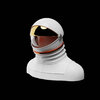tomekdersuaaron
New Member
For the past years I've been working on designing and fabricating a spacesuit I’m going to use in a project called the Ceres program. I think I must have read everything on this forum involving spacesuits, starting with Ryan Nagata’s Apollo A7L build, so I must thank you for all your knowledge and learnings.
It felt only fair I would make a thread of my own, to hopefully share some insight of what I’ve learned so far.
I want to use this thread to track the progress so this first post might be a long one.
This is where we currently are at:
But let me backup a bit to show where we started.
The Project
My whole youth was basically shaped by science fiction, I loved both Star Wars and Star Trek and from a young age I had a subscription to a science magazine that would always feature some facts about the universe. One thing that I’ve always noticed that even in these fantastical distant worlds, our own world always seemed to surprise and amaze me more. I’m making this suit with a friend for a project called Ceres program. The goal is to travel the world and photograph all the beautiful and diverse places our planet has to offer through a sci-fi lens from the point of view of astronauts looking for another planet for humanity.
Examples of pictures I've taken on holidays
Examples of astronauts visiting other worlds
Design overview
The reason I give this backstory is because then you understand our design has to be both aesthetic and functional. It doesn’t have to survive a vacuum, but it does have to be usable on multiple trips.
Design-wise it has to look in line with the current gen NASA EMU, but also distinct enough that it fits our own fiction.
First we started with a rough sketch of all the parts we would have to make.
We decided very early on to start with the pants first, because it seemed to need the least machines to fabricate.

Early sketches
It felt only fair I would make a thread of my own, to hopefully share some insight of what I’ve learned so far.
I want to use this thread to track the progress so this first post might be a long one.
This is where we currently are at:
|
|
But let me backup a bit to show where we started.
The Project
My whole youth was basically shaped by science fiction, I loved both Star Wars and Star Trek and from a young age I had a subscription to a science magazine that would always feature some facts about the universe. One thing that I’ve always noticed that even in these fantastical distant worlds, our own world always seemed to surprise and amaze me more. I’m making this suit with a friend for a project called Ceres program. The goal is to travel the world and photograph all the beautiful and diverse places our planet has to offer through a sci-fi lens from the point of view of astronauts looking for another planet for humanity.
Design overview
The reason I give this backstory is because then you understand our design has to be both aesthetic and functional. It doesn’t have to survive a vacuum, but it does have to be usable on multiple trips.
Design-wise it has to look in line with the current gen NASA EMU, but also distinct enough that it fits our own fiction.
First we started with a rough sketch of all the parts we would have to make.
We decided very early on to start with the pants first, because it seemed to need the least machines to fabricate.
Early sketches
Last edited:

